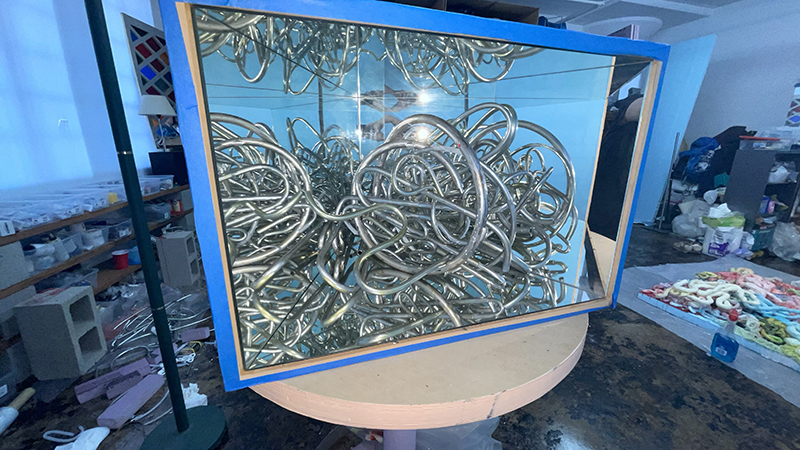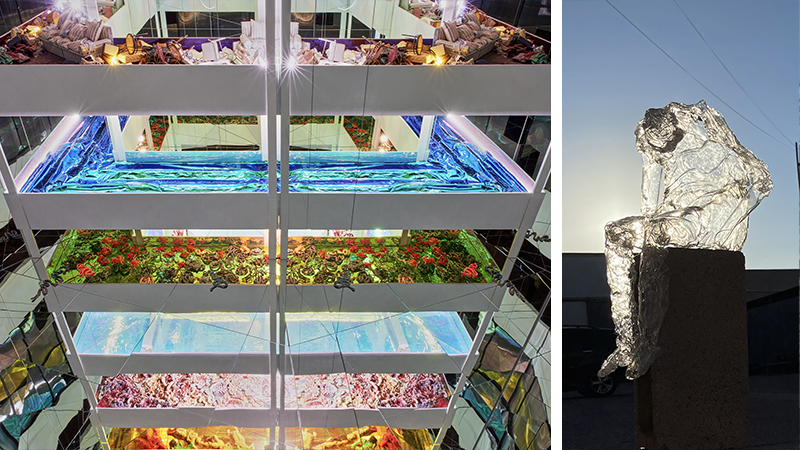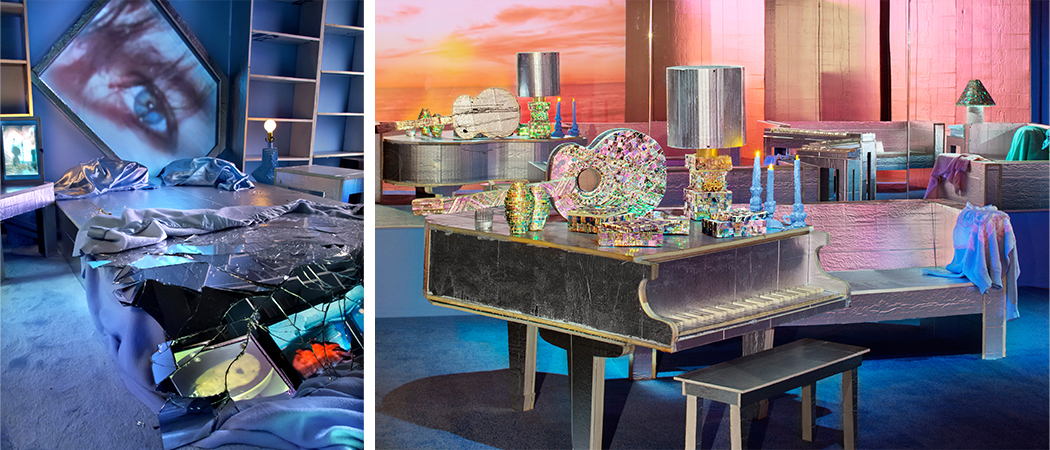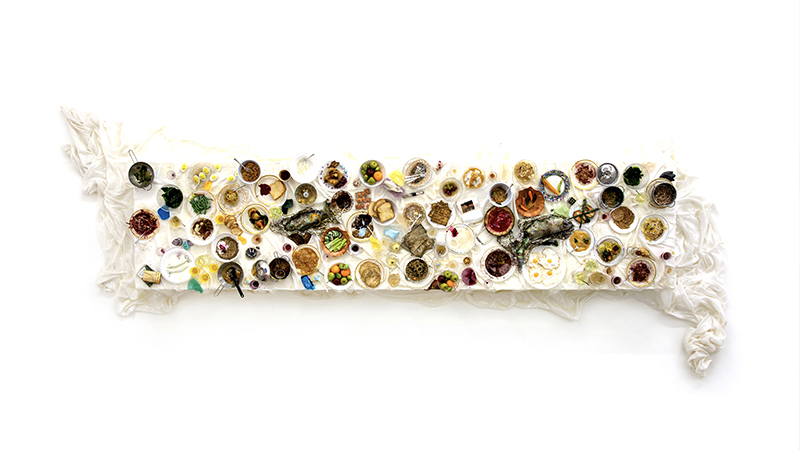… In our two souls, those twin mirrors.
Some evening made of rose and of mystical blue
A single flash will pass between us
Like a long sob, charged with farewells;
And later an Angel, setting the doors ajar,
Faithful and joyous, will come to revive
The tarnished mirrors, the extinguished flames.
—Charles Baudelaire

Objects in mirror are closer than they appear. A delicate engraving found lightly etched onto some looking glasses, these words warn us that though mirrors often unflinchingly reflect the world with their hard bounce of light, they can just as easily distort our perception. But in this instance, the distortion doesn’t alter the image with the warp and bend of a funhouse grotesque, but rather brings us closer. With these mirrors, the intimacy grows with the illusion, even if the distance is profound.
For over 13 years, I’ve been peering into the mirrors of the artist Samara Golden. In Rape of the Mirror in 2011, I saw the crash of emotion in the shattered promises of a mirrored bed shattered into tears beneath a creaming sunset. In Guts (2022), I saw the magic of her stacked world endlessly layered into the expansive problems and promise of our troubling times. In the shimmer and reflection of their glassy surfaces, I’ve discovered worlds upon worlds, feeling the emotional intimacy and illusionistic distance in each doubling. Here memory, psychology, history, architecture, and landscape layer like shimmering mirages into meditations on class and struggle, illness and isolation, love and loss. Through their ethereal silvers and iridescent turquoises, I have passed through memories and listened to ghosts, tiptoed through the rubble of disappointments, and peered into the phantasms of dreams. Throughout her many architectonic installations, Golden deploys mirrors and reflective materials into heartbreaking mise en abymes.
As clear as crystal and as gossamer as fantasy, holographically bent and dully gleaming, Golden’s mirrors can turn the world upside down and pass us into other dimensions. On the other side of the looking glass, as Lewis Carroll might tell you, the cruel absurdities and lush nonsense of the everyday can be betrayed for what they really are. Problems prism and puzzle, offering in their kaleidoscopic array the contrasts and tensions of poetry.

In Golden’s work, memory and emotion summon spaces that no longer exist or that never really existed except in our wounded hearts or collapsed together in our recollections. Everyday spaces fold over each other: a luxurious den teetering off a cliff, a party of humans composed with gratitude from those who make labor possible, two grandmothers’ houses fused into one, a smashed and windblown seaside resort as memorial, a scatter of isolated cells, a tableau of collective loneliness, an imaginary skyscraper writhing with fantasias and monsters stretching into infinity. All of these transcend through their cascaded reflections into a shattered grandeur. Golden’s mirrors summon lost spirits and tease out the pockmarked scars we carry from the lives and experiences we’ve led, not all of them on our faces. The mirrors and mirrored surfaces tell us with their infinities that there is always more to see.
Crafted with humble materials and scavenged decor, these installations and their sculptures are held together with pathos, whether as grand as that infinite skyscraper peered at from a second story perch, or as modest as faces like shades of those lost, burned into the reflective surfaces of construction insulation. Real furniture and objects blend with scrappily constructed simulacra, real cigarettes in an ersatz ashtray, a woven afghan tossed over the fragile silver board of a forged sofa. In the combined textures of the real and constructed, I can’t help but feel the solidity of some memories and the elusive wraiths of others, the palpability of certain dreams, and the thick mists obscuring the present from prying eyes.
These past years, wall works have emerged from her practice like potent shards shaved from larger installations. Melted figures like plastic Giacomettis in their contemplative leans and supine writhings find surprisingly complex emotional affect in the simple twist and turn of their bodies. Tables heave with half-eaten feasts like maximalist Daniel Spoerri’s, the tablecloths folding over the edges in shrouded pools of fabric as in Golden’s Where is my thinking cap? (2020). Or her dramatic Guts paintings (2022), emerging out of her Night Gallery exhibition of the same name but appearing in other exhibitions, where snaky spray foam tangles into a busy abattoir’s harvest of intestines, all painted with vivid harlequin chroma. The messy knots of intuition and indecision, of bravery and the disappointment of being “gutted” along with the visceral material in a bellyful life. The colors have their allure, but the snarl of all those messy innards can be stomach-churning, but so are the contrasts and force of our attempts to be courageous, intuitive, and disappointed in a difficult world.

I began this essay with Baudelaire’s lovers, the twin mirrors of their souls, as his mystic melancholia feels so fitting in looking through the mirrors into those worlds Golden conjures, as does the flame’s revival in their tarnished surfaces. I so often feel elegiac looking at her works and the world behind this that they envision: whether the ghosts of the past, the pain of the present, or the promises of the future, the dreams of what could have been or what will never be, and the hope that can be squeezed out of the beauty of her sixth-dimensional worlds swirl together just so, all wrought with a humble tenderness, gently sorrowful and just a little hopeful in their tremulous light.

Image Credits:
Hero Image Left: Illusion experiment in model, research for Golden’s 2024 exhibition at the Nasher Sculpture Center, 2023. Foamcore, wood, and mirror. Image courtesy of the artist
Hero Image Right: Samara Golden in studio, Los Angeles, 2024. Image courtesy of the artist
Thumbnail Image: Samara Golden, Mass Murder, Night Gallery, 2014. Installation view of Blue Room. Faux abalone piano, guitar, lamp, vases, ash tray, candles and jewelry, Rmax foam insulation, paint, cellophane and glue. Image courtesy of Night Gallery, Los Angeles
Images top to bottom, left to right
1: Samara Golden, experiment model, early research for Golden’s 2024 exhibition at the Nasher Sculpture Center, 2023. Wood, acrylic tubing, silver and brass paint, and mirror. Image courtesy of the artist
2: Samara Golden, Where is my thinking cap?, 2020. Extruded polystyrene foam board, epoxy, wood, fabric, polyurethane glue, caulk, acrylic paint, nail polish, aluminum foil, wrapping paper, plastic dishware, rubber bands, marbles, and found materials. 59 x 144 x 15 1/2 inches (149.9 x 365.8 x 39.4 cm). Photos by Nik Massey, courtesy of the artist and Night Gallery, Los Angeles
3: Samara Golden, study of figure made of melted plastic dinner plates, early research for Golden’s 2024 exhibition at the Nasher Sculpture Center, 2023. Image courtesy of the artist
4: Samara Golden, Rape of the Mirror: Bedroom Installation, 2011. Rmax foam insulation, mirror, monitors, carpet, projection, and various other media. Dimensions variable. Image courtesy of the artist and Night Gallery, Los Angeles
5: Samara Golden, Mass Murder, Night Gallery, 2014. Installation view of Blue Room. Faux abalone piano, guitar, lamp, vases, ash tray, candles and jewelry, Rmax foam insulation, paint, cellophane and glue. Image courtesy of Night Gallery, Los Angeles
6: Samara Golden, Where is my thinking cap?, 2020. Extruded polystyrene foam board, epoxy, wood, fabric, polyurethane glue, caulk, acrylic paint, nail polish, aluminum foil, wrapping paper, plastic dishware, rubber bands, marbles, and found materials. 59 x 144 x 15 1/2 inches (149.9 x 365.8 x 39.4 cm). Photos by Nik Massey, courtesy of the artist and Night Gallery, Los Angeles